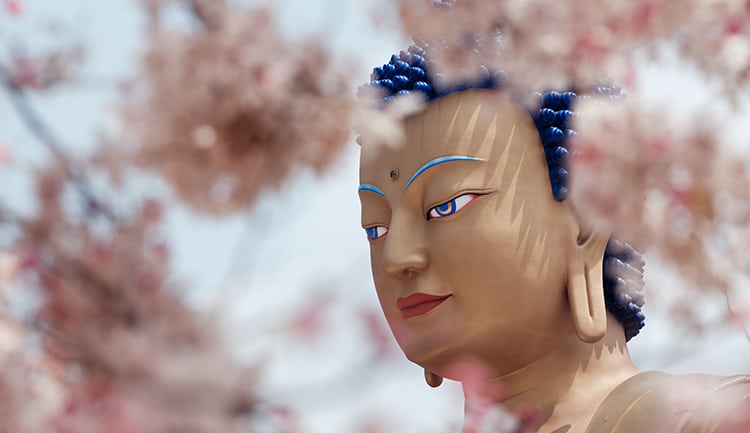What Is Buddhism?
Category: Buddhist Path | Recent Meditation Posts

What is the essence of Buddhism? In this article, learn what defines Buddhism and what Buddhists believe.
Buddhism Definition and Facts
Buddhism originated in India approximately 2,600 years ago when the Buddha gave his first teaching on the four noble truths. Buddhism can be considered a religion, a philosophy, a spiritual path and a way of life. Not everyone who practices would call themselves ‘Buddhists,’ nor would they necessarily refer to themselves as religious. Those who do account for approximately 7-10% of the world’s population, making Buddhism the 4th largest religion worldwide.
Statisticians disagree as to whether Buddhism is growing or declining. In part, this is due to the fluidity of what defines Buddhism. Today, in Southeast Asian countries such as Cambodia and Thailand over 90% of the population identifies as Buddhist. The greatest number of Buddhists, over 250 million, live in China. In North America, the Buddhist population is just under 4 million, but growing at a faster rate than elsewhere in the world.
Buddhist History
Buddhism arose around the 6th century BCE, at a time of great intellectual growth in India. The Buddhist worldview is rooted in logic but is something we come to understand via first-hand experience, just as the Buddha did through his own spiritual inquiry in meditation practice. Born as a prince named Siddhartha, the Buddha was once confined to his royal pleasure palace. Curious, he ventured outside the gates where he observed the suffering of old age, sickness and death. Moved by what he saw, he wondered if it was possible to be free from such pain.
Seeking a means of liberation from this dukkha, or discontentment, he began a spiritual journey that culminated in his awakening while meditating under the bodhi tree. He first shared what he learned about liberation from suffering with a small group of ascetics. Over the next 300 years, the Buddha’s teachings spread throughout India and into Southeast Asia, Central and North Asia and even parts of what is now Europe. More recently, Buddhism has touched people in all parts of the globe.
Schools of Buddhism
As Buddhism spread, differing schools of Buddhism began to develop. Each agrees on the Four Noble Truths; that suffering exists and we can free ourselves from it. Buddhist schools differ slightly, however, on how they understand the true nature of suffering and its cessation. Theravada Buddhism is the oldest form of Buddhism still practiced today. The Mahayana school arose later, around the 1st or 2nd century CE.
Translated as “the great vehicle,” Mahayana Buddhism emphasizes the bodhisattva path, in which one seeks enlightenment not for individual liberation, but for the liberation of all beings. The Mahayana school encompasses the most ancient Theravada teachings, but also a vast body of more recently recorded works.
Buddhist Symbolism and Meaning
Buddhism has a rich history of visual representation. What we might refer to today as Buddhist ‘art’ served primarily as guides for practice. The viewer would have understood the symbolism and meaning of each work. Perhaps the most ubiquitous symbols of Buddhism are the three jewels of Buddha, Dharma and Sangha. These are represented by blue, yellow and red jewels or as a trident.
The Buddha, often symbolized seated in meditation upon a lotus, reminds us that it is possible for a human being to awaken to the truth of suffering and liberate themselves from it. The lotus flower represents the profound teaching that Buddha nature is pure and unstained by samsara. Other common Buddhist symbols include the dharma wheel, representing what was set in motion when the Buddha gave his first teaching. The 8 spokes of the wheel represent the eightfold path to freedom from suffering.
What Buddhists Believe
Buddhists beliefs are not rooted in blind faith, but are evidenced through direct experience. The Buddha himself famously asked his followers not to accept his words out of respect, but to test their effectiveness for themselves. What’s more, belief in Buddhist philosophy or meditation alone is not what changes our lives. Change occurs through the action of practice.
Through practice, Buddhists come to understand that our own mistaken perceptions are the cause of our suffering. By behaving in an ethical manner, meditating and developing wisdom, we can change our minds and hence our experience of ourselves and our world.
Core Buddhist Teachings
The Buddha’s first teaching on the four noble truths introduces the eightfold path as a map to the end of suffering. Other well-known core Theravada teachings include the ethical teachings of the 5 precepts, meditation teachings on the four foundations of mindfulness and the 5 hindrances. This body of teachings includes wisdom about the true nature of self, and the appearance of samsara and nirvana.
Mahayana teachings include insights into the true nature of existence and the truth that all beings have the potential to awaken. Every authentic Mahayana Buddhist teaching is marked with one or more of the four seals. This includes the teachings that all conditioned things are impermanent, that all such contaminated things are unsatisfactory, that all phenomena are empty of self, and that only the experience of wisdom is bliss.








